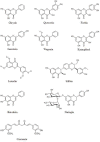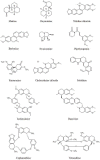Modulation of Multiple Signaling Pathways of the Plant-Derived Natural Products in Cancer
- PMID: 31781485
- PMCID: PMC6856297
- DOI: 10.3389/fonc.2019.01153
Modulation of Multiple Signaling Pathways of the Plant-Derived Natural Products in Cancer
Abstract
Natural compounds are highly effective anticancer chemotherapeutic agents, and the targets of plant-derived anticancer agents have been widely reported. In this review, we focus on the main signaling pathways of apoptosis, proliferation, invasion, and metastasis that are regulated by polyphenols, alkaloids, saponins, and polysaccharides. Alkaloids primarily affect apoptosis-related pathways, while polysaccharides primarily target pathways related to proliferation, invasion, and metastasis. Other compounds, such as flavonoids and saponins, affect all of these aspects. The association between compound structures and signaling pathways may play a critical role in drug discovery.
Keywords: alkaloid; cancer; natural active compounds; polyphenol; polysaccharide; saponin; signaling pathway.
Copyright © 2019 Sun, Zhou, Zhang, Guo, Yang, Li, Sun, Gao and Cui.
Figures








Similar articles
-
A map describing the association between effective components of traditional Chinese medicine and signaling pathways in cancer cells in vitro and in vivo.Drug Discov Ther. 2014 Aug;8(4):139-53. doi: 10.5582/ddt.2014.01032. Drug Discov Ther. 2014. PMID: 25262593 Review.
-
Perspectives of Plant Natural Products in Inhibition of Cancer Invasion and Metastasis by Regulating Multiple Signaling Pathways.Curr Med Chem. 2018;25(38):5057-5087. doi: 10.2174/0929867324666170918123413. Curr Med Chem. 2018. PMID: 28925869 Review.
-
New anticancer agents: recent developments in tumor therapy.Anticancer Res. 2012 Jul;32(7):2999-3005. Anticancer Res. 2012. PMID: 22753764 Review.
-
Targeting multiple myeloma with natural polyphenols.Eur J Med Chem. 2019 Oct 15;180:465-485. doi: 10.1016/j.ejmech.2019.07.041. Epub 2019 Jul 16. Eur J Med Chem. 2019. PMID: 31330448 Review.
-
In vitro and in vivo antitumoral effects of combinations of polyphenols, or polyphenols and anticancer drugs: perspectives on cancer treatment.Int J Mol Sci. 2015 Apr 24;16(5):9236-82. doi: 10.3390/ijms16059236. Int J Mol Sci. 2015. PMID: 25918934 Free PMC article. Review.
Cited by
-
Modulation of Apoptosis by Plant Polysaccharides for Exerting Anti-Cancer Effects: A Review.Front Pharmacol. 2020 May 27;11:792. doi: 10.3389/fphar.2020.00792. eCollection 2020. Front Pharmacol. 2020. PMID: 32536869 Free PMC article. Review.
-
Anabasis setifera leaf extract from arid habitat: A treasure trove of bioactive phytochemicals with potent antimicrobial, anticancer, and antioxidant properties.PLoS One. 2024 Oct 25;19(10):e0310298. doi: 10.1371/journal.pone.0310298. eCollection 2024. PLoS One. 2024. PMID: 39453934 Free PMC article.
-
Phenolic acids and a static magnetic field change the expression of transforming growth factor β isoforms in amelanotic melanoma cells.Mol Biol Rep. 2023 May;50(5):4207-4216. doi: 10.1007/s11033-023-08336-1. Epub 2023 Mar 10. Mol Biol Rep. 2023. PMID: 36899279 Free PMC article.
-
A spotlight on alkaloid nanoformulations for the treatment of lung cancer.Front Oncol. 2022 Oct 18;12:994155. doi: 10.3389/fonc.2022.994155. eCollection 2022. Front Oncol. 2022. PMID: 36330493 Free PMC article. Review.
-
The Modulatory Influence of Plant-Derived Compounds on Human Keratinocyte Function.Int J Mol Sci. 2021 Nov 19;22(22):12488. doi: 10.3390/ijms222212488. Int J Mol Sci. 2021. PMID: 34830374 Free PMC article. Review.
References
Publication types
LinkOut - more resources
Full Text Sources

